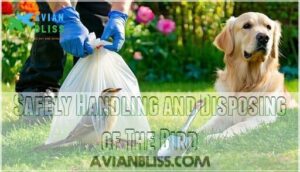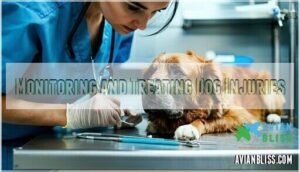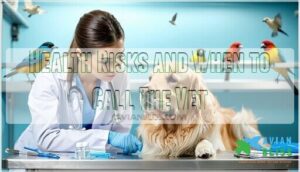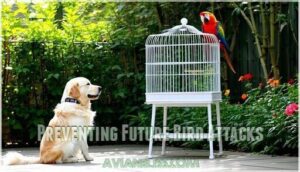This site is supported by our readers. We may earn a commission, at no cost to you, if you purchase through links.

Understanding why it happened matters because it reveals what’s driving your dog’s behavior and shows you how to prevent it from happening again. The right steps after an incident protect your dog’s health, address hidden risks like disease transmission, and give you a clear path forward to keep all your pets safe.
Table Of Contents
- Key Takeaways
- Why Dogs Attack Birds: Key Causes
- Immediate Actions After a Dog Kills a Bird
- Health Risks and When to Call The Vet
- Preventing Future Bird Attacks
- Creating a Safe Home for All Pets
- Frequently Asked Questions (FAQs)
- Why did my dog kill my pet bird?
- What to do after your dog kills a bird?
- What should I do if my dog ate my bird?
- Will my dog get sick from killing a bird?
- How to handle guilt and anger towards your dog?
- Can a dogs prey drive be completely eliminated?
- Are certain dog breeds more likely to kill birds?
- How to rebuild trust between dog and other pets?
- Should I rehome my dog after it killed a bird?
- Can dogs get bird flu from dead birds?
- Conclusion
Key Takeaways
- Dogs kill birds due to hardwired predatory instincts, not malice—even well-trained dogs can react automatically when movement triggers their ancient chase reflex, especially in breeds like terriers, retrievers, and herding dogs bred for hunting.
- After an incident, immediately wear gloves to handle the bird carcass, disinfect all surfaces, check your dog for wounds or illness symptoms (vomiting, lethargy, respiratory distress), and contact your vet since wild birds carry diseases like salmonella and parasites.
- Prevention requires layered strategies: teach reliable recall and "leave it" commands through consistent training, remove bird feeders and use physical barriers in your yard, and never leave dogs unsupervised around pet birds.
- You can’t eliminate prey drive completely, but you can manage it through daily practice with distraction training, impulse control exercises, and enrichment activities that redirect your dog’s hunting energy into puzzle toys and scent work.
Why Dogs Attack Birds: Key Causes
When a dog kills a bird, it’s not random cruelty—it’s usually rooted in natural instincts or gaps in training. Understanding why this happens helps you prevent it from occurring again.
Here are the key causes behind these incidents.
Prey Drive and Predatory Instincts
Dogs don’t chase birds out of spite—they’re responding to a primal instinct that’s been hardwired into their DNA for thousands of years. This predatory drive mirrors the hunting instincts of their wolf ancestors, where movement triggers an immediate chase response.
Prey animals like birds activate these predatory behaviors automatically. Even well-trained dogs can struggle with drive fulfillment, making early socialization and redirecting instincts essential for managing these powerful dog instincts.
Breed-Specific Tendencies
Certain breeds carry stronger hunting instincts than others. Sporting breeds like Retrievers and Pointers were bred for bird hunting, making them highly responsive to feathered movement. Terrier instincts drive smaller breeds to chase anything that flutters or runs.
Understanding your dog’s breed predisposition helps you anticipate and manage their bird-chasing behavior more effectively. These dogs often require consistent positive reinforcement during training.
Here’s what you’ll see in breeds with high prey drive:
- Herding breeds (Border Collies, Australian Shepherds) instinctively chase moving targets
- Hound traits in Beagles and Greyhounds trigger relentless pursuit behaviors
- Retrievers and Spaniels exhibit natural bird-focused attention
- Jack Russell Terriers display intense small-animal targeting
- Even mixed breeds inherit these predatory instincts from their genetic background
Lack of Training or Socialization
Even dogs with strong instincts won’t automatically know what’s off-limits without proper training and early exposure to other animals. Early socialization shapes how your dog reacts to birds and other small creatures. Without impulse control practice and consistent training, you’ll see reactive chasing instead of calm behavior.
Here’s how training gaps create problems:
| Training Gap | Behavioral Result |
|---|---|
| No recall reliability | Dog ignores commands when excited |
| Poor leash manners | Lunging at birds during walks |
| Limited exposure to birds | Overstimulation and predatory response |
| Inconsistent boundaries | Confusion about what’s acceptable |
| No behavior modification | Reinforced bird-chasing patterns |
Dog training methods that build impulse control prevent these tragic incidents before they happen.
Misinterpreted Play Versus Aggression
What looks like harmless play—pouncing, chasing, even a soft mouth—can escalate into a fatal attack faster than you might expect. Your dog’s body language cues reveal whether you’re seeing playful vs. predatory behavior. Excitement vs. threat signals differ dramatically, and inappropriate play needs immediate redirecting behavior.
Understanding dog aggression patterns helps you intervene before play turns deadly. Watch for these triggering events that shift dog behavior:
- Stiff body posture instead of loose, bouncy movements
- Silent stalking rather than vocal, energetic chasing
- Fixed stare and lowered head indicating predatory drive
- Shaking or killing bite after catching the bird
Immediate Actions After a Dog Kills a Bird
When your dog kills a bird, acting quickly helps protect your pet’s health and keeps your home safe.
You’ll need to approach the situation carefully to reduce risks from bacteria and parasites.
Here’s what to do right away to manage the aftermath and prevent complications.
Safely Handling and Disposing of The Bird
When a dog kills a bird, your first priority is protecting yourself and your family from potential health hazards lurking in the carcass.
Always wear gloves before touching the bird carcass to avoid bacterial infections and parasites. If gloves aren’t available, use a plastic bag or shovel for safe removal.
Dispose of the bird by burying it or wrapping it securely to prevent other animals from accessing it. Sterilize any tools you used and discard contaminated soil immediately.
Cleaning and Disinfecting The Area
After removing the bird carcass, bacteria and pathogens can linger on surfaces where the incident occurred—so disinfecting thoroughly isn’t optional. Use safe disinfectants to clean up the area and eliminate contamination risks like salmonella and other bacterial infections.
Sterilize any tools that contacted the bird to prevent animal infections. Proper disposal of contaminated materials reduces health risks for your family and pets.
Monitoring and Treating Dog Injuries
Even if your dog seems fine after the attack, checking for injuries—like scratches, puncture wounds, or swelling—protects against hidden infections that can worsen without treatment.
Follow these wound care steps:
- Rinse any bite wound with clean water and apply antiseptic.
- Watch for infection signs like redness, discharge, or fever.
- Check your dog’s throat for pain management needs—she may have irritated her esophagus.
- Schedule veterinary follow-up if internal injuries or worsening symptoms appear.
Documenting The Incident for Records
Keeping a written record of what happened—date, time, bird species, and your dog’s behavior—isn’t just paperwork; it’s a safety net if patterns emerge or future vet visits require context. Photo documentation of any bite wound or injuries helps veterinarians assess internal injuries later.
Track these details:
| What to Record | Why It Matters | Example |
|---|---|---|
| Incident timeline | Identifies behavioral patterns | "10:15 AM, backyard" |
| Dog’s reaction | Shows aggression vs. prey drive | "Excited, not aggressive" |
| Injuries sustained | Reinforces veterinary records and legal considerations | "Minor scratch on paw" |
Health Risks and When to Call The Vet
When a dog kills a bird, your first concern should be your dog’s health. Wild birds can carry diseases and parasites that transfer through contact, bites, or ingestion.
Here’s what you need to know about the risks and when it’s time to call your vet.
Diseases and Parasites Dogs Can Catch From Birds
Wild birds carry multiple risks for your dog. Bacterial infections like salmonella can cause gastroenteritis, while zoonotic parasites including roundworms, hookworms, and protozoan risks like Giardia transmit through contact with infected carcasses. Avian influenza remains a concern, though major illness in dogs is rare.
Environmental contamination from bird droppings increases infection rates—studies show 26% of dogs test positive for intestinal parasites and worms linked to bird exposure. These threats can lead to septicemia if left untreated, compromising your dog’s animal health. Dogs can contract zoonotic diseases from infected birds.
Symptoms to Watch for in Your Dog
Once your dog has been exposed to a wild bird, symptoms can appear within hours or take several days to surface—either way, you’ll want to know what warning signs demand your attention.
Watch for lethargy signs, appetite changes, and digestive issues like vomiting or diarrhea. Respiratory distress—coughing or labored breathing—signals serious dog health concerns.
Check for wounds during your examination, and don’t ignore any symptoms of distress in dogs that seem unusual for your pet.
Importance of Deworming and Vaccinations
Your dog’s regular deworming schedule and up-to-date vaccinations serve as your first line of defense against the infections wild birds carry. Parasite prevention and vaccine schedules protect against zoonotic diseases that threaten both dogs and public health. Your veterinarian designs preventative care to boost immunity against these specific risks.
- Deworming protocols eliminate parasites before they cause serious illness
- Core vaccines shield your dog from viral and bacterial infections transmitted by wildlife
- Regular veterinary check-ups adjust protection based on your dog’s exposure and lifestyle
When to Seek Veterinary Attention
Contact your veterinarian immediately if your dog shows vomiting, diarrhea, lethargy, coughing, or respiratory distress after contact with a dead bird. These symptoms in dogs signal potential bacterial infections or parasites requiring diagnostic testing and medication options.
Emergency veterinary care becomes critical if choking hazard signs appear or behavioral changes worsen. Wound assessment and follow-up care make certain complications don’t develop from scratches or exposure to contaminated feathers.
Preventing Future Bird Attacks
Once you’ve addressed the immediate health concerns, it’s time to focus on breaking the pattern before it happens again. Training your dog to ignore birds takes patience, but it’s manageable with the right approach.
Here are four practical strategies that can help reduce your dog’s interest in chasing or attacking birds.
Distraction and Positive Reinforcement Training
Training your dog to ignore birds doesn’t require endless practice sessions—it starts with smart redirection and rewards that feel like a game. Try these behavior modification techniques:
- Toy redirection: Use a toy on a string to mimic bird movement, then reward your dog with a treat when they chase it instead
- Consistent rewards: Give immediate praise during early intervention moments to strengthen impulse control
- Gradual exposure: Practice recall training near birds at increasing distances as your dog improves
This approach makes dog training effective without feeling like work.
Using Commands Like Recall and “Leave It”
Mastering a few simple verbal cues can mean the difference between a calm walk and a frantic chase when birds flutter into view. Start with recall training in a low-distraction environment, then add birds gradually. Command consistency matters—use the same words every time.
| Command | When to Use |
|---|---|
| Recall ("Come") | Dog fixates on distant birds |
| Leave It | Dog approaches or mouths bird |
| Stay/Wait | Birds nearby during leash walks |
Practice both commands daily for recall effectiveness and leave it nuances in behavior modification.
Physical Barriers and Bird Deterrents
Sometimes the best defense isn’t teaching your dog better manners—it’s simply making your yard less appealing to feathered visitors in the first place. Remove feeders and birdbaths to reduce habitat appeal, and consider these barriers:
- Netting effectiveness increases when draped over shrubs where birds perch
- Bird-safe fencing around garden beds discourages ground foraging
- Visual deterrents like reflective tape or fake owls startle incoming flocks
- Attach a bell to your dog’s collar so birds hear them coming
- Scat mats near favorite bird zones keep dogs away without harsh corrections
Combine habitat modification with supervision for pet bird safety.
Professional Training and Consistency
If your dog’s bird-chasing habit won’t quit, trainer certifications matter. Certified professionals like CPDT-KA holders bring 300+ hours of experience and understand animal behavior deeply.
They use consistent commands and reinforcement timing—rewarding the instant your dog obeys—to reshape predatory behaviors. Owner patience is key; rushed dog training methods backfire.
Avoid training pitfalls like mixed signals or delayed rewards. Professional guidance transforms preventing dog attacks from frustrating to achievable.
Creating a Safe Home for All Pets
After a traumatic incident, you need to rebuild your home environment so every pet feels secure. This means thinking through housing, habits, and daily routines with fresh eyes.
Let’s walk through the key changes that protect both your dog and any birds in your space.
Secure Housing and Supervised Interactions
When dogs and birds share the same space, even a split second of unsupervised access can turn deadly—so the first line of defense is creating physical separation that your dog can’t breach. Invest in safe enclosures with secure latches for pet birds, and never allow supervised playtime without a leash on your dog.
Constant vigilance during gradual introductions helps you assess reactions, while separate spaces guarantee preventative measures work. Leash training reinforces pet safety and preventing bird kills starts with control.
Environmental Changes to Deter Birds
If your yard feels like an all-you-can-eat buffet for wild birds, you’re basically setting up a hunting ground that tempts even the most well-behaved dog. Remove feeders and clean up spilled seed to reduce bird traffic.
Install fake predators like owls, use bird-repellent plants around the perimeter, or try sonic deterrents. Habitat modification discourages birds from landing, while keeping your dog on a leash during supervised yard time prevents chasing behavior.
Enrichment Activities for Dogs
A bored dog with pent-up energy isn’t just restless—it’s a ticking time bomb that’ll redirect natural instincts toward whatever moves, chirps, or flutters by.
Channel that drive with puzzle toys, scent work, and agility training that engage your dog’s brain and body. Interactive play and socialization games tire out hunting instincts better than any backyard patrol, reducing prey-related stressors before exercise alone ever could.
Addressing Emotional Impact and Family Support
Losing a pet bird cuts deep—even when your dog’s predatory instincts are to blame, the trauma hits every family member differently. Grief recognition matters because 55% of adults and up to 55% of children show considerable depression or anxiety after pet loss, yet only one in five pet owners receive adequate support. Support barriers like disenfranchised grief leave families isolated during a crisis that animal welfare experts compare to human bereavement.
Pet loss grief hits hard—55% of families suffer depression or anxiety, yet only one in five receive the support they desperately need
- Validate each person’s emotions—children and adults process pet loss on different timelines and need individualized family coping strategies
- Offer tangible help like meals or chores to reduce stress while the pet owner complicated feelings
- Create memorial rituals together—writing letters or sharing memories strengthens family bonds and normalizes grief
- Seek professional help if symptoms persist beyond a year or interfere with daily life, as structured counseling greatly reduces distress
Frequently Asked Questions (FAQs)
Why did my dog kill my pet bird?
Your dog’s prey drive can feel like a betrayal—but instinct doesn’t ask permission.
Dogs attack birds due to predatory instincts, breed predisposition, lack of training, or environmental factors that trigger their natural hunting behavior, even with supervision.
What to do after your dog kills a bird?
Your first priority is carcass disposal—wear gloves and use a plastic bag to prevent bacteria and parasite exposure.
Disinfect the area thoroughly, check your dog for wounds requiring veterinary examination, and monitor behavior for signs of shock or negative reaction.
Record the incident details for preventing future bird kills.
What should I do if my dog ate my bird?
Contact your veterinarian immediately if your dog ate a bird. The vet will assess risks like bacterial infections, parasites from the carcass, or internal injuries from sharp bones. Monitor for vomiting, diarrhea, or lethargy while awaiting consultation.
Will my dog get sick from killing a bird?
Yes, your dog can get sick from killing a bird. Bird-borne diseases like salmonella pose a health risk, along with parasite transmission and potential wound infections.
Monitor your pet closely and watch for symptoms that may require veterinary attention to protect your dog’s health.
How to handle guilt and anger towards your dog?
Emotions complicate logic, yet guilt and anger stem from natural dog behavior, not malice. Acknowledge feelings without blame.
Recognize predatory instincts drove your dog’s actions—not spite. Seek therapy if emotions persist.
Reframe perspective: dogs lack moral reasoning about canine aggression.
Can a dogs prey drive be completely eliminated?
No, prey drive can’t be fully eliminated—it’s hardwired through domestication and breed differences. Training limitations mean you can manage predatory instincts in dogs through ethical considerations and management strategies, but predatory drive remains part of natural dog behavior.
Are certain dog breeds more likely to kill birds?
Certain breeds carry hunting instincts like a loaded spring. Breeds with strong predatory drive—terriers, hounds, and retrievers—often show heightened interest in birds due to genetic factors and breed predisposition, though training can substantially reduce risk.
How to rebuild trust between dog and other pets?
Rebuilding trust starts with separate spaces and gradual re-integration under close supervision. Use positive associations through treats and calm interactions during supervised playtime.
Watch for predatory behaviors or aggression signals. Create safe introductions that prioritize safety for all pets, allowing your dog’s behavior to prove reliability over time before increasing freedom together.
Should I rehome my dog after it killed a bird?
Ironically, one bird’s death doesn’t define your dog’s entire character. Rehoming isn’t usually necessary unless aggression escalates beyond predatory behaviors.
Focus on training, safety measures, and preventing future attacks—most dogs can learn impulse control with consistency.
Can dogs get bird flu from dead birds?
While bird flu risks exist, transmission routes to dogs remain relatively uncommon. Dog susceptibility is low, but contact with infected wild birds poses potential danger.
Preventative measures include wearing gloves during disposal and monitoring dog health closely. Seek veterinary guidance if you notice unusual medical conditions in dogs after exposure.
Conclusion
Think of a gate left unlatched—the damage happens faster than you can react. When my dog killed my bird, the key isn’t guilt; it’s action.
Check your dog for illness, secure your spaces, and commit to consistent training. Prevention requires vigilance, not flawlessness.
Your dog’s instincts won’t vanish, but with proper barriers, recall commands, and environmental management, you can stop tragedy before it strikes. Safety isn’t accidental—it’s built through deliberate, informed choices every single day.
- https://stories.tamu.edu/news/2025/04/01/more-than-99-of-us-dogs-have-a-behavior-problem-texas-am-researcher-finds/
- https://pmc.ncbi.nlm.nih.gov/articles/PMC8048238/
- https://dogtraining.world/knowledge-base/interdog-household-aggression-38-cases/
- https://beachvol.birdlife.org.au/public_files/40/Dog%20management%20solutions.pdf
- https://www.audubon.org/news/why-leashing-dogs-easy-way-protect-birds-and-their-chicks










